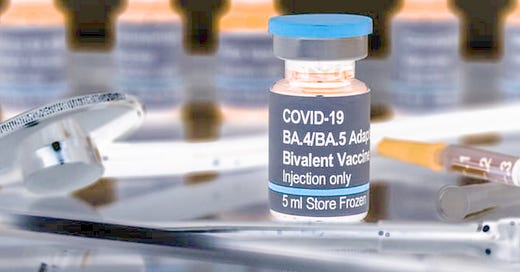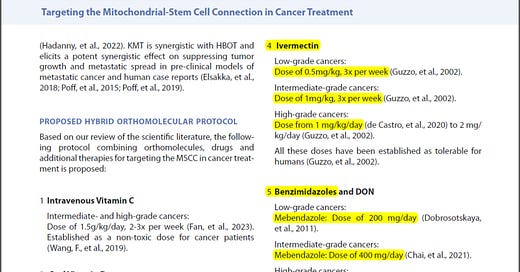
VAIDS Rising: Large Study’s Disturbing Results: Questionable Bivalent Booster Performance--the Greater the Previous mRNA Doses the Greater the Risk for Infection
“However, the majority of subjects in this study were generally young individuals and all were eligible to have received at least 3 doses of vaccine by the study start date, and which they had every o
The DEATHVAX™ is certainly living up to its name, and then some…
Cleveland Clinic researchers, led by physician and infectious disease specialist Dr. Nabin K Shrestha, conducted a large retrospective cohort study tapping into robust data associated with the Cleveland Clinic Health System (CCHS) involving 51,977 study subjects and a total of 10,804 employees that were bivalent vaccine boosted. How effective were these vaccines in stopping COVID-19? 89% of those (9595) were vaccinated with BNT162b2 (Pfizer-BioNTech), and the remaining 1,178 with mRNA-1273 (Moderna). By the 13th week of this study, 2542 employees (5%) contracted COVID-19. The observational study involving CCHS employees involved evaluation of those employees who received the bivalent COVID-19 vaccine released September 2022. The investigators embraced a methodology treating bivalent vaccination as a time-dependent covariate, allowing for determining vaccine effectiveness in real time. With a majority of SARS-CoV-2 cases in Ohio involving BA.4 and BA.5 Omicron sub-variants during the first 10 weeks of the study (Ohio Department of Health data), by December, the most active sub-variants become BQ.1, BQ.1.1, and BF.7 lineages. The CCHS investigators conducted a range of statistical analyses, from a Simon-Makuch hazard plot comparing the cumulative incidence of COVID-19 in the bivalent vaccinated and non-vaccinated states (bivalent vaccination treated as a time-dependent covariate), as well as multivariable Cox proportional hazards regression models fitted to evaluate the association of various study variables with time to COVID-19 (Bivalent vaccination included as a time-dependent covariate). Two models were constructed, including a primary model (all study subjects) and secondary model (persons with prior SARS-CoV-2 infection of vaccination). All analyses were crunched in the survival package and R version 4.2.2. The study authors found that the current bivalent vaccines were only about 30% effective overall in protecting against SARS-CoV-2 infection when the Omicron BA.4/BA.5 lineages were predominantly in circulation in Ohio. Furthermore, the data reveals the greater number of mRNA doses, the greater the incidence of SARS-CoV-2 infection. Unfortunately, this isn’t a great look.
What do we learn from this study? What follows is a TrialSite breakdown. We remind that this study has yet to be peer reviewed, thus should not be cited as evidence.
A Building—Crile Building
Source: Cleveland Clinic
High level findings and TrialSite POV
With a total of 51,011 Cleveland Clinic Health System employees, 20689 (41%) had a previous documented episode of COVID-19, and 42,064 (83%) received at least two doses of a COVID-19 vaccine. COVID-19 occurred in 2452 (5%) during the study. In a bombshell finding (but not surprising given growing data), the risk of COVID-19 increased with time since the most recent prior COVID-19 episode, and importantly, with the number of vaccine doses previously received.
The investigators’ multivariable analysis revealed that there was some decent news in that the bivalent vaccinated state was independently associated with lower risk of COVID-19 (HR, .70; 95% C.I., .61-.80), leading to an estimated vaccine effectiveness (VE) of 30% (95% CI, 20-39%) for this point in time. Compared to last exposure to SARS-CoV-2 within 90 days, the last exposure 6-9 months previously was associated with twice the risk of COVID-19, and last exposure 9-12 months previously with 3.5 times the risk. Importantly, the mRNA COVID-19 vaccines continue to exhibit durability challenges, and the 30% vaccine effectiveness rate will likely wane rather quickly. Given the risk for COVID-19 increases with the number of vaccine doses previously received, the whole premise of the current COVID-19 vaccination scheme must be reconsidered. If looked at as a tool used for surges during the pandemic to mitigate risk of serious infection, they can be considered successful less a true independent analysis of actual risks to various age cohorts. But declaring these products as a universal success given the tremendous social upheaval associated with the program (mandates, etc.) represents more of a political agenda than a scientific one.
What’s the strength of this study?
Although the results must still go through peer review, the Cleveland Clinic-based study includes the following elements making this a robust study:
Large sample size
Conducted in a healthcare system, it demonstrates early recognition of importance of maintenance of effective workforce during pandemic led to devotion of resources to generate an accurate accounting of who had COVID-19, who received vaccines, and when (robust, accurate records).
What are key limitations to this study?
As with all observational studies, limitations must be accounted for. The authors provide several limitations, and their interpretation of how and why the risks associated with these limiting factors may be mitigated. For those interested in a deep dive, we recommend a direct read.
What is a possible explanation for weaker than expected vaccine effectiveness?
A substantial part of the study population may have had a prior asymptomatic Omicron variant infection. For instance, the authors point out that approximately 33% of SARS-CoV-2 infections have been estimated to be asymptomatic in studies that have been done in different places.
So, if this was in fact the case, the “protection from the bivalent vaccine may have been masked because those with prior Omicron variant infection may have already been somewhat protected.” For example, the authors back this claim with a CDC seroprevalence study done in February 2022 showing that:
“64% of the 18-64 age-group population and 75% of children and adolescents had serologic evidence of prior SARS-CoV-2 infection, with almost half of the positive serology attributed to infections that occurred between December 2021, and February 2022, which would have predominantly been Omicron BA.1/BA.2 lineage infections. With such a large proportion of the population expected to have already been previously exposed to the Omicron variant of SARS-CoV-2, there could be some concern that a substantial proportion of individuals may be unlikely to derive substantial benefit from a bivalent vaccine.”
Of course, this observation begs the question: if the CDC’s own data reveals this likely reality, why push the bivalent booster so hard to so many people?
What are the implications of these findings?
Rather than outright saying the original approach declaring that the vaccines would control the pandemic—one driven by a dynamic mutating RNA virus—the authors suggest that rather “a more nuanced approach to assessing the potential impact of vaccination” is now required. For example, “additional factors beyond vaccine effectiveness need to be considered.”
What was an unexpected reality associated with the study findings?
The study findings showed an association of greater risk of COVID-19 infection with higher numbers of prior vaccine doses. Put simply, the more people vaccinated, the more the SARS-CoV-2 transmission.
What is a possible explanation for this unexpected finding?
Persons that received more doses were likely at higher risk for COVID-19 anyway. That is the elderly, persons with comorbidities, immunosuppressed, etc. But this doesn’t make too much sense. The study authors themselves acknowledge:
“However, the majority of subjects in this study were generally young individuals and all were eligible to have received at least 3 doses of vaccine by the study start date, and which they had every opportunity to do.”
So, the authors point out that those persons that avoided CDC recommendations actually got infected less than those that followed CDC recommendations getting infected more?
Yes. The authors declared, “Despite this, their risk of acquiring COVID-19 was lower than those who received a larger number of prior vaccine doses.”
Are there other studies that find a possible association of higher prior vaccine doses and higher risk of COVID-19?
Yes. The authors point to a large study that found that those who had an Omicron variant infection after previously receiving three doses of vaccine had a higher risk of reinfection than those who had an Omicron variant infection after previously receiving two doses of vaccine. See the link. Note, this too is not peer reviewed yet.
Another study uncovered that those persons who received two or three mRNA COVID-19 vaccine doses following prior COVID-19 faced a higher risk of reinfection than receipt of a single dose. See the link. (also needs peer review).
Should some humility be involved here?
Absolutely. The authors importantly convey that “We still have a lot to learn about protection from COVID-19 vaccination, and in addition to a vaccine’s effectiveness it is important to examine whether multiple vaccine doses given over time may not be having the beneficial effect that is generally assumed.”
What does the Cleveland Clinic-led team conclude?
The authors in the TrialSite opinion to some degree protect their professional positions by declaring the bivalent booster vaccines bring an “overall modest protective effect” for protecting working-aged adults against COVID—19. Given the findings that the more mRNA doses are associated with greater number of infections, the implications are considerable for dynamics such as immune tolerance, and the authors concur that “the effect of multiple COVID-19 vaccine doses on future risk of COVID-19 needs further study.” The true value of these COVID-19 vaccines must be pegged to actual contribution. They indeed helped reduce risk at times of key surges less associated risks not fully studied or understood.
But mounting data also suggests in the aggregate that more doses equal higher risk, and this reality, if accurate, doesn’t align well with the universal success story branding program governments and industry continuously promulgate nor the vast economic taking vaccine producers have secured.
Lead Research/Investigator
Nabin K Shrestha, MD, MPH infectious disease specialist and Corresponding Author
Source: Cleveland Clinic
Patrick C. Burke, Infection Prevention, Cleveland Clinic
Amy S. Nowacki, Quantitative Health Sciences, Cleveland Clinic
James F. Simon, Enterprise Business Intelligence, Cleveland Clinic
Amanda Hagen, Occupational Health, Cleveland Clinic
Steven M. Gordon, Departments of Infectious Diseases, Cleveland Clinic
References
Do NOT comply.

















Thanks, great study find. We are finally seeing legit evidence-based studies that aren’t biased. Maybe Big Pharma has finally run out of scientists they can pay off. We WILL hit a tipping point soon & the evidence will be undeniable. These vaccines should never have been approved. My hope is FDA officials that were involved in initial E.U. approval, are found and held accountable.
( As well as Fauci, Gates, & all the rest)
Thanks again, keep up the fight to expose this! ✌🏼
As Ethical Skeptic commented on Telegram....."Falling Covid cases is not good news for the Narrative Ninnies. They have no place to hide the 7,400 Excess Non-Covid Natural Cause deaths we are seeing each week now".